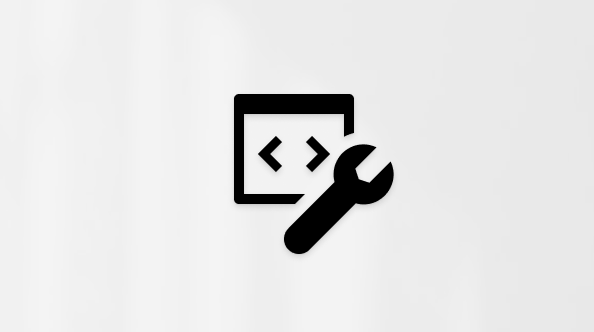Many users find that using an external keyboard with keyboard shortcuts for Access desktop databases on Windows helps them work more efficiently. For users with mobility or vision disabilities, keyboard shortcuts can be easier than using the touchscreen and are an essential alternative to using a mouse.
Notes:
-
The shortcuts in this topic refer to the US keyboard layout. Keys for other layouts might not correspond exactly to the keys on a US keyboard.
-
A plus sign (+) in a shortcut means that you need to press multiple keys at the same time.
-
A comma sign (,) in a shortcut means that you need to press multiple keys in order.
-
This topic assumes that JAWS users have the Virtual Ribbon Menu feature turned off.
In this topic
Frequently used shortcuts
This table itemizes the most frequently used shortcuts in Access desktop databases.
|
To do this |
Press |
|---|---|
|
Select the active tab of the ribbon and activate KeyTips. |
Alt or F10 |
|
Go to the Home tab. |
Alt+H |
|
Go to the Tell me box on the ribbon. |
Alt+Q, and then enter the search term |
|
Display the shortcut menu for the selected item. |
Shift+F10 or the Windows Menu key |
|
Move the focus to a different pane of the window. |
F6 |
|
Open an existing database. |
Ctrl+O or Ctrl+F12 |
|
Show or hide the Navigation Pane. |
F11 |
|
Show or hide a property sheet. |
F4 |
|
Switch between Edit mode (with insertion point displayed) and Navigation mode in the Datasheet View or Design View. |
F2 |
|
Switch to the Form View from the form in the Design View. |
F5 |
|
Move to the next or previous field in the Datasheet View. |
Tab key or Shift+Tab |
|
Go to a specific record in the Datasheet View. |
Alt+F5, then, in the record number box, type the record number and press Enter |
|
Open the Print dialog box (for datasheets, forms, and reports). |
Ctrl+P |
|
Open the Page Setup dialog box (for forms and reports). |
S |
|
Open the Find tab in the Find and Replace dialog box in the Datasheet View or Form View. |
Ctrl+F |
|
Open the Help window. |
F1 |
|
Exit Access. |
Alt+F4 |
Work with database files
Learn how to use your keyboard to open and save databases and print database information.
Open and save databases
|
To do this |
Press |
|---|---|
|
Open a new database. |
Ctrl+N |
|
Open an existing database. |
Ctrl+O or Ctrl+F12 |
|
Open the selected folder or file. |
Enter |
|
Open the folder one level above the selected folder. |
Backspace |
|
Delete the selected folder or file. |
Delete |
|
Display a shortcut menu for a selected item such as a folder or file. |
Shift+F10 or the Windows Menu key |
|
Move forward through options. |
Tab key |
|
Move backward through options. |
Shift+Tab |
|
Open the Look in list. |
F4 or Alt+I |
|
Save a database object. |
Ctrl+S or Shift+F12 |
|
Open the Save As dialog box. |
F12 or Alt+F, S |
Print database information
|
To do this |
Press |
|---|---|
|
Print the current or selected object. |
Ctrl+P |
|
From Print Preview, open the Print dialog box. |
P or Ctrl+P |
|
From Print Preview, open the Page Setup dialog box. |
S |
|
Cancel Print Preview or Layout Preview. |
C or Esc |
|
From the File menu, return to your database. |
Esc |
Work with text boxes, combo boxes, and list boxes
Use your keyboard to navigate and edit content in a text box, combo box, or list box.
Edit a text box
An edit box is a blank text box in which you type or paste an entry, such as your username or the path of a folder.
|
To do this |
Press |
|---|---|
|
Move to the beginning of the entry. |
Home |
|
Move to the end of the entry. |
End |
|
Move one character to the left or right. |
Left or Right arrow key |
|
Move one word to the left or right. |
Ctrl+Left or Right arrow key |
|
Select from the insertion point to the beginning of the text entry. |
Shift+Home |
|
Select from the insertion point to the end of the text entry. |
Shift+End |
|
Change the selection by one character to the left. |
Shift+Left arrow key |
|
Change the selection by one character to the right. |
Shift+Right arrow key |
|
Change the selection by one word to the left. |
Ctrl+Shift+Left arrow key |
|
Change the selection by one word to the right. |
Ctrl+Shift+Right arrow key |
Use a combo or list box
A list box displays a range of unchangeable values or choices, which are automatically listed. A combo box also displays values or choices, but it does not display them until you select a dropdown arrow. With a combo box, you can sometimes enter a value that’s not on the list, as you can with a text box.
|
To do this |
Press |
|---|---|
|
Open a combo box. |
F4 or Alt+Down arrow key |
|
Refresh the contents of the Lookup field list box or a combo box. |
F9 |
|
Move down one line. |
Down arrow key |
|
Move down one page. |
Page down |
|
Move up one line. |
Up arrow key |
|
Move up one page. |
Page up |
|
Exit the combo box or list box. |
Tab key |
Work with objects
Use keyboard shortcuts to edit and move within the Objects list and to navigate and open objects.
Edit and navigate the Objects list
|
To do this |
Press |
|---|---|
|
Rename a selected object. Note: You can only rename an object when it is closed. |
F2 |
|
Move down one line. |
Down arrow key |
|
Move down one window. |
Page down |
|
Move to the last object. |
End |
|
Move up one line. |
Up arrow key |
|
Move up one window. |
Page up |
Navigate and open objects
|
To do this |
Press |
|---|---|
|
Open the selected table or query in the Datasheet View. |
Enter |
|
Open the selected form or report. |
Enter |
|
Run the selected macro. |
Enter |
|
Open the selected table, query, form, report, macro, or module in the Design View. |
Ctrl+Enter |
|
Display the Immediate window in the Visual Basic Editor. |
Ctrl+G |
Common shortcuts for the Design, Layout, and Datasheet views
|
To do this |
Press |
|---|---|
|
Switch between Edit mode (with insertion point displayed) and Navigation mode in a datasheet. |
F2 |
|
Exit Navigation mode and return to Edit mode in a form or report. |
Esc |
|
Switch to the property sheet (in the Design View and Layout View for forms and reports). |
F4 or Alt+Enter |
|
Switch to the Form View from the form in the Design view. |
F5 |
|
Switch between the upper and lower portions of a window (in the Design View of queries, macros, and the Advanced Filter/Sort window). |
F6 |
|
Cycle between the field grid, property sheet, field properties, the Navigation Pane, Quick Access Toolbar, and KeyTips on the ribbon (in the Design View for tables). |
F6 |
|
Switch from the Visual Basic Editor back to the form or report in the Design View. |
Alt+F11 |
|
Toggle forward between views when in a table, query, form, or report. Note: If additional views are available, successive keystrokes move the focus to the next available view. |
Ctrl+Right arrow key or Ctrl+Comma (,) |
|
Toggle backward between views when in a table, query, form, or report. Note: If additional views are available, successive keystrokes move the focus to the previous view. |
Ctrl+Left arrow key or Ctrl+Period (.) Note: This shortcut does not work under all conditions with all objects. |
Work in the Datasheet View
Use the Datasheet View when you work with tables and queries.
Navigate between fields and records
These keyboard shortcuts work in Navigation mode in the Datasheet View.
|
To do this |
Press |
|---|---|
|
Move to the next field. |
Tab key or Right arrow key |
|
Move to the last field in the current record. |
End |
|
Move to the previous field. |
Shift+Tab or Left arrow key |
|
Move to the first field in the current record. |
Home |
|
Move to the current field in the next record. |
Down arrow key |
|
Move to the current field in the last record. |
Ctrl+Down arrow key |
|
Move to the last field in the last record. |
Ctrl+End |
|
Move to the current field in the previous record. |
Up arrow key |
|
Move to the current field in the first record. |
Ctrl+Up arrow key |
|
Move to the first field in the first record. |
Ctrl+Home |
|
Go to a specific record. |
Alt+F5, then, in the record number box, type the record number and press Enter |
Navigate to another screen of data
|
To do this |
Press |
|---|---|
|
Move up one screen. |
Page up |
|
Move down one screen. |
Page down |
|
Move right one screen. |
Ctrl+Page down |
|
Move left one screen. |
Ctrl+Page up |
Select and move a column
|
To do this |
Press |
|---|---|
|
Select the current column or cancel the column selection, in Navigation mode only. |
Ctrl+Spacebar |
|
Extend the selection one column to the right, if the current column is selected. |
Shift+Right arrow key |
|
Extend the selection one column to the left, if the current column is selected. |
Shift+Left arrow key |
Work with subdatasheets
|
To do this |
Press |
|---|---|
|
Enter the subdatasheet from the last field of the previous record in the datasheet. |
Tab key |
|
Enter the subdatasheet from the first field of the following record in the datasheet. |
Shift+Tab |
|
Exit the subdatasheet and move to the first field of the next record in the datasheet. |
Ctrl+Tab |
|
Exit the subdatasheet and move to the last field of the previous record in the datasheet. |
Ctrl+Shift+Tab |
|
From the last field in the subdatasheet, enter the next field in the datasheet. |
Tab key |
|
From the datasheet, bypass the subdatasheet and move to the next record in the datasheet. |
Down arrow key |
|
From the datasheet, bypass the subdatasheet and move to the previous record in the datasheet. |
Up arrow key |
|
Go to a specific record in a subdatasheet. Note: This moves the focus from the subdatasheet to the record number box. |
Alt+F5, then, in the record number box, type the record number and press Enter |
|
Move from the datasheet to the record's subdatasheet. |
Ctrl+Shift+Down arrow key |
|
Collapse the subdatasheet. |
Ctrl+Shift+Up arrow key |
Note: To navigate between fields and records in a subdatasheet, use the same keyboard shortcuts you use in the Datasheet View.
Work in the Design View
You work in the Design View when you design tables, queries, forms, reports, and macros.
Navigate in the Design View
|
To do this |
Press |
|---|---|
|
Switch between Edit mode (with insertion point displayed) and Navigation mode. |
F2 |
|
Open or close the property sheet. |
F4 or Alt+Enter |
|
Switch to the Form View from a form in the Design View. |
F5 |
|
Switch between the upper and lower portions of a window (in the Design View of queries, macros, and the Advanced Filter/Sort window). Note: Use F6 if the Tab key does not take you to the section of the screen you want. |
F6 |
|
Toggle forward between the design pane, properties, Navigation Pane, ribbon, and Zoom controls (in the Design View of tables, forms, and reports). |
F6 |
|
Show or hide the Field List pane. |
Alt+F8 |
|
When you have a code module open, switch from the Visual Basic Editor to the form or report in the Design View. |
Shift+F7 |
|
Switch from a control's property sheet in a form or report in the Design View to the design surface without changing the control focus. |
Shift+F7 |
|
Copy the selected control to the clipboard. |
Ctrl+C |
|
Cut the selected control and copy it to the clipboard. |
Ctrl+X |
|
Paste the contents of the clipboard in the upper-left corner of the selected section. |
Ctrl+V |
|
Move the selected control to the right by a pixel along the page's grid. |
Right arrow key |
|
Move the selected control to the left by a pixel along the page's grid. |
Left arrow key |
|
Move the selected control up by a pixel along the page's grid. Note: For controls in a stacked layout, this switches the position of the selected control with the control directly above it, unless it is already the uppermost control in the layout. |
Up arrow key |
|
Move the selected control down by a pixel along the page's grid. Note: For controls in a stacked layout, this switches the position of the selected control with the control directly below it, unless it is already the lowermost control in the layout. |
Down arrow key |
|
Move the selected control to the right by a pixel (irrespective of the page's grid). |
Ctrl+Right arrow key |
|
Move the selected control to the left by a pixel (irrespective of the page's grid). |
Ctrl+Left arrow key |
|
Move the selected control up by a pixel (irrespective of the page's grid). Note: For controls in a stacked layout, this switches the position of the selected control with the control directly above it, unless it is already the uppermost control in the layout. |
Ctrl+Up arrow key |
|
Move the selected control down by a pixel (irrespective of the page's grid). Note: For controls in a stacked layout, this switches the position of the selected control with the control directly below it, unless it is already the lowermost control in the layout. |
Ctrl+Down arrow key |
|
Increase the width of the selected control to the right by a pixel. Note: For controls in a stacked layout, this increases the width of the whole layout. |
Shift+Right arrow key |
|
Decrease the width of the selected control to the left by a pixel. Note: For controls in a stacked layout, this decreases the width of the whole layout. |
Shift+Left arrow key |
|
Decrease the height of the selected control from the bottom by a pixel. |
Shift+Up arrow key |
|
Increase the height of the selected control from the bottom by a pixel. |
Shift+Down arrow key |
Edit using controls in the form and report in the Design View
|
To do this |
Press |
|---|---|
|
Copy the selected control to the clipboard. |
Ctrl+C |
|
Cut the selected control and copy it to the clipboard. |
Ctrl+X |
|
Paste the contents of the clipboard in the upper-left corner of the selected section. |
Ctrl+V |
|
Move the selected control to the right (except a control that is part of a layout). |
Right arrow key or Ctrl+Right arrow key to move in smaller increments |
|
Move the selected control to the left (except a control that is part of a layout). |
Left arrow key or Ctrl+Left arrow key to move in smaller increments |
|
Move the selected control up (except a control that is part of a layout). |
Up arrow key or Ctrl+Up arrow key to move in smaller increments |
|
Move the selected control down (except a control that is part of a layout). |
Down arrow key or Ctrl+Down arrow key to move in smaller increments |
|
Increase the height of the selected control. Note: If used with a control that is in a layout, the entire row of the layout is resized. |
Shift+Down arrow key |
|
Increase the width of the selected control. Note: If used with a control that is in a layout, the entire column of the layout is resized. |
Shift+Right arrow key |
|
Reduce the height of the selected control. Note: If used with a control that is in a layout, the entire row of the layout is resized. |
Shift+Up arrow key |
|
Reduce the width of the selected control. Note: If used with a control that is in a layout, the entire column of the layout is resized. |
Shift+Left arrow key |
Work with panes
Learn how to use keyboard shortcuts with diagram, grid, SQL, or Field List panes.
Use a diagram pane
|
To do this |
Press |
|---|---|
|
Move among tables, views, and functions (and join lines, if available). |
Tab key or Shift+Tab |
|
Move between columns in a table, view, or function. |
Arrow keys |
|
Choose the selected data column for output. |
Spacebar or Plus sign (+) |
|
Remove the selected data column from the query output. |
Spacebar or Minus sign (-) |
|
Remove the selected table, view, or function, or join line from the query. |
Delete |
Note: If multiple items are selected, pressing Spacebar affects all selected items. Select multiple items by holding down Shift while selecting them. Toggle the selected state of a single item by holding down Ctrl while selecting it.
Use a grid pane
|
To do this |
Press |
|---|---|
|
Move among cells. |
Arrow keys, Tab key, or Shift+Tab |
|
Move to the last row in the current column. |
Ctrl+Down arrow key |
|
Move to the first row in the current column. |
Ctrl+Up arrow key |
|
Move to the upper-left cell in the visible portion of grid. |
Ctrl+Home |
|
Move to the lower-right cell. |
Ctrl+End |
|
Move in a dropdown list. |
Up or Down arrow key |
|
Select an entire grid column. |
Ctrl+Spacebar |
|
Toggle between Edit mode and cell selection mode. |
F2 |
|
Copy the selected text in a cell to the clipboard (in Edit mode). |
Ctrl+C |
|
Cut the selected text in a cell and place it on the clipboard (in Edit mode). |
Ctrl+X |
|
Paste text from the clipboard (in Edit mode). |
Ctrl+V |
|
Toggle between insert and overtype mode while editing in a cell. |
Insert |
|
Toggle the checkbox in the Output column. Note: If multiple items are selected, pressing this key affects all selected items. |
Spacebar |
|
Clear the selected contents of a cell. |
Delete |
|
Clear all values for a selected grid column. |
Delete |
Use an SQL pane
You can use the standard Windows editing keys when working in the SQL pane. For example, you can use Ctrl+arrow keys to move between words, and the Cut, Copy, and Paste commands on the Home tab work as they normally do. You can only insert text; there is no overtype mode.
Note: In the SQL view, Ctrl+A to select all text is only supported in Microsoft 365, Access 2016 Click-to-Run, Access 2021, and Access 2019. As an alternative, press F2.
Use the Field List pane with a form or report in the Design View or Layout View
|
To do this |
Press |
|---|---|
|
Show or hide the Field List pane. |
Alt+F8 |
|
Add the selected field to the form or report detail section. |
Enter |
|
Move up or down the Field List pane. |
Up or Down arrow key |
|
Move between the upper and lower panes of the Field List. |
Tab key |
Select text or data
Learn how to use your keyboard to select a field, record, or text within a field. You can also use keyboard shortcuts to extend your selection or find and replace text or data.
Select a field or record
Note: To cancel a selection, use the opposite arrow key.
|
To do this |
Press |
|---|---|
|
Select the next field. |
Tab key |
|
Switch between Edit mode (with insertion point displayed) and Navigation mode in a datasheet. |
F2 |
|
Exit Navigation mode in a form or report. |
Esc |
|
Switch between selecting the current record and the first field of the current record, in Navigation mode. |
Shift+Spacebar |
|
Extend the selection to the previous record, if the current record is selected. |
Shift+Up arrow key |
|
Select all records. |
Ctrl+A |
Select text in a field
|
To do this |
Press |
|---|---|
|
Change the size of the selection by one character to the right. |
Shift+Right arrow key |
|
Change the size of the selection by one word to the right. |
Ctrl+Shift+Right arrow key |
|
Change the size of the selection by one character to the left. |
Shift+Left arrow key |
|
Change the size of the selection by one word to the left. |
Ctrl+Shift+Left arrow key |
Extend a selection
|
To do this |
Press |
|---|---|
|
Turn on Extend mode. Note: In the Datasheet View, Extended Selection appears in the lower-right corner of the window. |
F8, then repeatedly F8 to extend the selection to the word, the field, the record, and all records |
|
Extend a selection to adjacent fields in the same row in the Datasheet View. |
Left or Right arrow key |
|
Extend a selection to adjacent rows in the Datasheet View. |
Up or Down arrow key |
|
Undo the previous extension. |
Shift+F8 |
|
Cancel Extend mode. |
Esc |
Find and replace text or data
|
To do this |
Press |
|---|---|
|
Open the Find tab in the Find and Replace dialog box. |
Ctrl+F |
|
Find the next occurrence of the text specified in the Find and Replace dialog box when the dialog box is closed (in the Datasheet View and Form View only). |
Shift+F4 |
Edit text or data
Use the keyboard shortcuts in the following sections to navigate to an insertion point within a field, copy, move, or delete text, and undo changes. You can also use your keyboard to enter data in the Datasheet View or Form View and refresh fields.
Move the insertion point in a field
Note: If the insertion point is not visible, press F2 to display it.
|
To do this |
Press |
|---|---|
|
Move the insertion point one character to the right. |
Right arrow key |
|
Move the insertion point one word to the right. |
Ctrl+Right arrow key |
|
Move the insertion point one character to the left. |
Left arrow key |
|
Move the insertion point one word to the left. |
Ctrl+Left arrow key |
|
Move the insertion point to the end of the field in single-line fields, or move it to the end of the line in multiline fields. |
End |
|
Move the insertion point to the end of the field, in multiline fields. |
Ctrl+End |
|
Move the insertion point to the beginning of the field in single-line fields, or move it to the beginning of the line in multiline fields. |
Home |
|
Move the insertion point to the beginning of the field, in multiline fields. |
Ctrl+Home |
Copy, move, or delete text
|
To do this |
Press |
|---|---|
|
Copy the selection to the clipboard. |
Ctrl+C |
|
Cut the selection and copy it to the clipboard. |
Ctrl+X |
|
Paste the contents of the clipboard at the insertion point. |
Ctrl+V |
|
Delete the selection or the character to the left of the insertion point. |
Backspace |
|
Delete the selection or the character to the right of the insertion point. |
Delete |
|
Delete all characters to the right of the insertion point. |
Ctrl+Delete |
Undo changes
|
To do this |
Press |
|---|---|
|
Undo typing. |
Ctrl+Z or Alt+Backspace |
|
Undo changes in the current field or current record. |
Esc |
Enter data in the Datasheet View or Form View
|
To do this |
Press |
|---|---|
|
Insert the current date. |
Ctrl+Semicolon (;) |
|
Insert the current time. |
Ctrl+Shift+Colon (:) |
|
Insert the default value for a field. |
Ctrl+Alt+Spacebar |
|
Insert the value from the same field in the previous record. |
Ctrl+Apostrophe (') |
|
Add a new record. |
Ctrl+Plus sign (+) |
|
In a datasheet, delete the current record. |
Ctrl+Minus sign (-) |
|
Save changes to the current record. |
Shift+Enter |
|
Switch between the values in a checkbox or option button. |
Spacebar |
|
Insert a new line in a Short Text or Long Text field. |
Ctrl+Enter |
Refresh fields with current data
|
To do this |
Press |
|---|---|
|
Requery the underlying tables or in a subform, requery the underlying table only for the subform. |
Shift+F9 or F5 |
|
Refresh the contents of a Lookup field list or combo box. |
F9 |
Get help with Access
The Help window provides all Access help content.
|
To do this |
Press |
|---|---|
|
Open the Help window. |
F1 |
|
Select the next item in the Help window. |
Tab key |
|
Select the previous item in the Help window. |
Shift+Tab |
|
Perform the action for the selected item. |
Enter |
|
Select the next hidden text or hyperlink. |
Tab key |
|
Select the previous hidden text or hyperlink. |
Shift+Tab |
|
Perform the action for the selected hidden text, or hyperlink. |
Enter |
|
Move back to the previous Help topic (Back button). |
Alt+Left arrow key or Backspace |
|
Scroll small amounts up or down within the currently displayed Help topic. |
Up or Down arrow key |
|
Scroll larger amounts up or down, respectively, within the currently displayed Help topic. |
Page up or Page down |
Miscellaneous keyboard shortcuts
|
To do this |
Press |
|---|---|
|
Display the complete hyperlink address (URL) for a selected hyperlink. |
F2 |
|
Open the Zoom box to conveniently enter expressions and other text in small input areas. |
Shift+F2 |
|
Copy a screenshot of the entire screen to the clipboard. |
Print screen |
|
Copy a screenshot of the current window to the clipboard. |
Alt+Print screen |
|
Display the full set of commands on the task pane menu. |
Ctrl+Down arrow key |
|
Exit Access. |
Alt+F4 |
See also
Technical support for customers with disabilities
Microsoft wants to provide the best possible experience for all our customers. If you have a disability or questions related to accessibility, please contact the Microsoft Disability Answer Desk for technical assistance. The Disability Answer Desk support team is trained in using many popular assistive technologies and can offer assistance in English, Spanish, French, and American Sign Language. Please go to the Microsoft Disability Answer Desk site to find out the contact details for your region.
If you are a government, commercial, or enterprise user, please contact the enterprise Disability Answer Desk.











